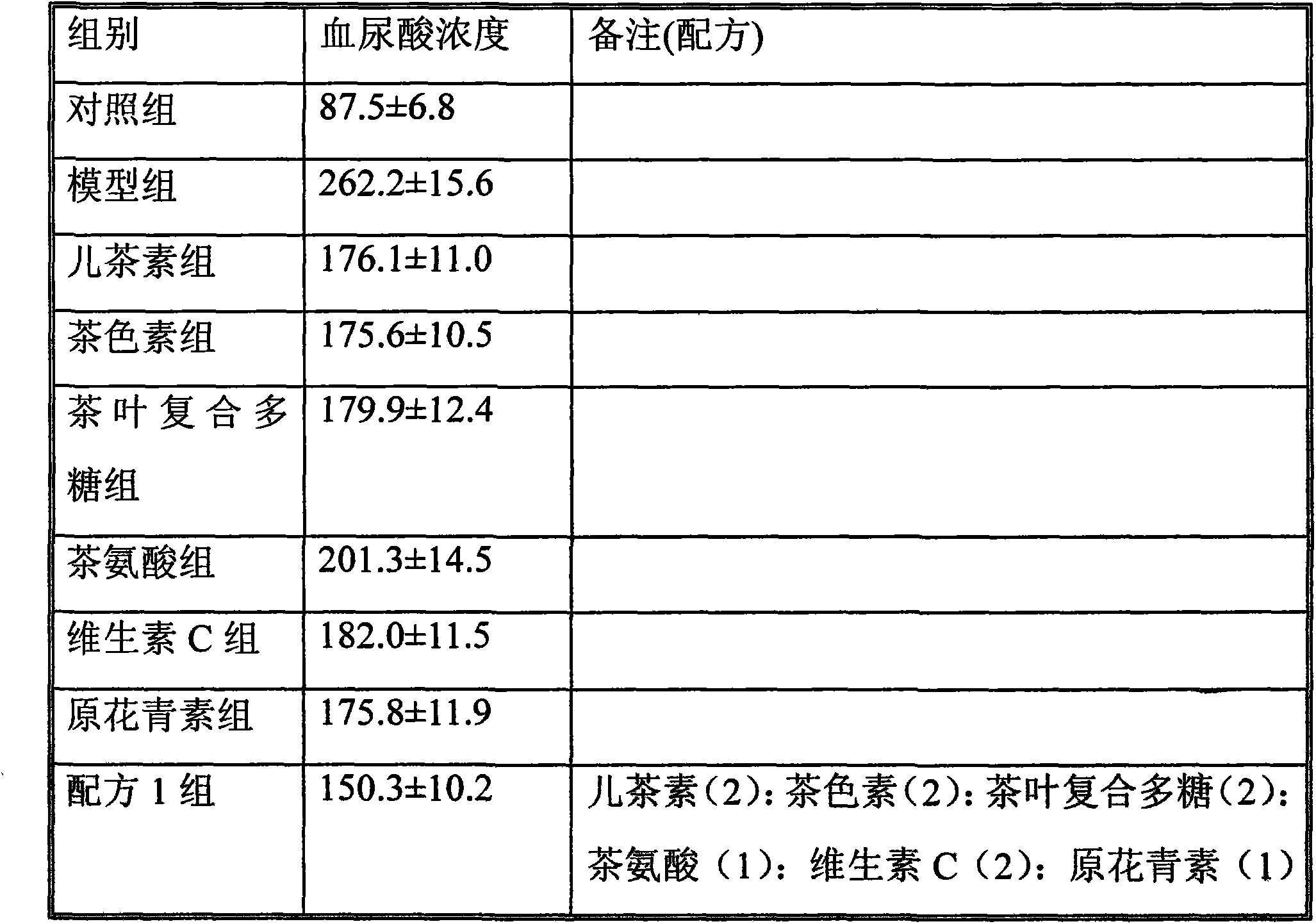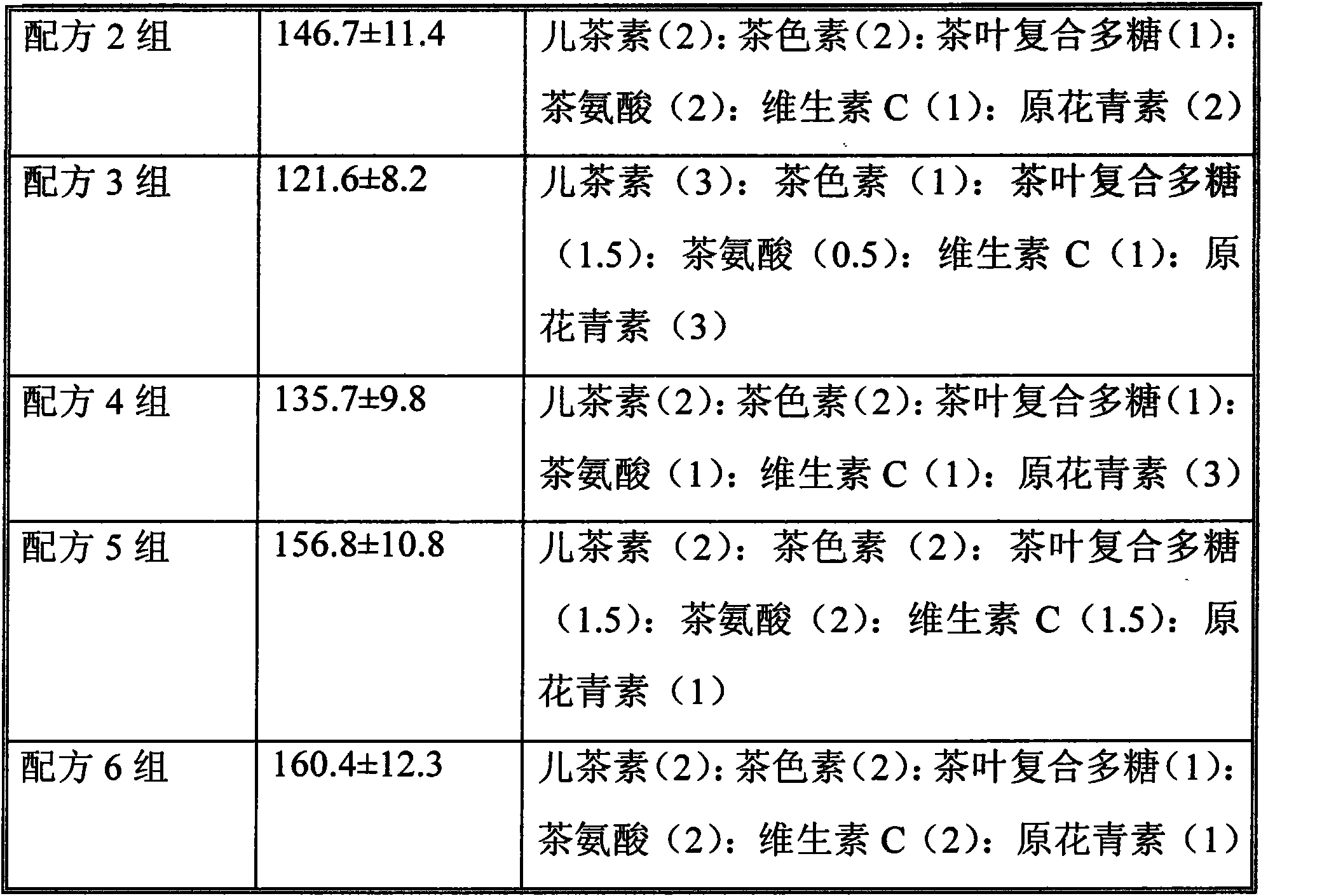Medicine for reducing uric acid
A technology for lowering uric acid and drugs, which can be used in drug combinations, pharmaceutical formulations, plant raw materials, etc., and can solve problems such as lack of research on synergistic effects of tea functional components
- Summary
- Abstract
- Description
- Claims
- Application Information
AI Technical Summary
Problems solved by technology
Method used
Image
Examples
Embodiment 1
[0013] Male Kunming mice were divided into control group and hyperuricemia group [intraperitoneal injection of oxonic acid potassium salt method (300mg / kg one-time intraperitoneal injection) to prepare animal model of hyperuricemia], hyperuricemia group and They were randomly divided into a model group and a uric acid-lowering drug (200mg / kg) treatment group. After one week of treatment, the rats were killed to detect the blood uric acid level. The proportions of the components of the present invention and the orthogonal test were used to determine the proportions of the components of the uric acid-lowering drug, and the results shown in Table 1 were obtained.
[0014] Table 1 shows that various components reduce blood uric acid in hyperuricemia model mice ( μmol / L):
[0015] Table 1
[0016]
[0017]
[0018] As shown in Table 1, any single component in catechin, tea pigment, tea compound polysaccharide, theanine, vitamin C, and proanthocyanidin has different degrees...
Embodiment 2
[0020] Male Kunming mice were divided into control group and hyperuricemia group [the method of intraperitoneal injection of oxonic acid potassium salt (300mg / kg one-time intraperitoneal injection) to prepare animal model of hyperuricemia], hyperuricemia group and They were randomly divided into model group, benzbromarone (20mg / kg) treatment group, allopurinol (40mg / kg) treatment group, compound uric acid-lowering drugs (catechin 30%, tea pigment 10%, tea compound polysaccharide 15%) %, theanine 5%, vitamin C 10%, proanthocyanidins 30%, 200mg / kg) treatment group, the treatment group was given benzbromarone 20mg / kg, allopurinol 40mg / kg, and uric acid-lowering drugs 200mg / kg. Stomach for 7 days, observed changes in blood uric acid, blood lipids, xanthine oxidase activity, and renal function levels of mice in each group, and the results shown in Table 2 were obtained.
[0021] Table 2 shows the comparison of concentrations of blood uric acid, cholesterol, triacylglycerol, urea ni...
Embodiment 3
[0026] Male Kunming mice were divided into control group and hyperuricemia group [the method of intraperitoneal injection of oxonic acid potassium salt (300mg / kg one-time intraperitoneal injection) to prepare animal model of hyperuricemia], hyperuricemia group and They were randomly divided into model group, benzbromarone (20mg / kg) treatment group, allopurinol (40mg / kg) treatment group, uric acid-lowering drugs (catechin 20%, tea pigment 20%, tea compound polysaccharide 10%) , theanine 20%, vitamin C 20%, proanthocyanidins 10%, 200mg / kg) treatment group, the treatment group were given 20mg / kg benzbromarone, 40mg / kg allopurinol, 200mg / kg lowering uric acid drugs After 7 days, the changes of blood uric acid, blood lipid, xanthine oxidase activity, and renal function levels of mice in each group were observed, and the results shown in Figure 3 were obtained. Table 3 Comparison of blood uric acid, cholesterol, triacylglycerol, blood urea nitrogen, creatinine, and xanthine oxidase ...
PUM
 Login to View More
Login to View More Abstract
Description
Claims
Application Information
 Login to View More
Login to View More - R&D
- Intellectual Property
- Life Sciences
- Materials
- Tech Scout
- Unparalleled Data Quality
- Higher Quality Content
- 60% Fewer Hallucinations
Browse by: Latest US Patents, China's latest patents, Technical Efficacy Thesaurus, Application Domain, Technology Topic, Popular Technical Reports.
© 2025 PatSnap. All rights reserved.Legal|Privacy policy|Modern Slavery Act Transparency Statement|Sitemap|About US| Contact US: help@patsnap.com



